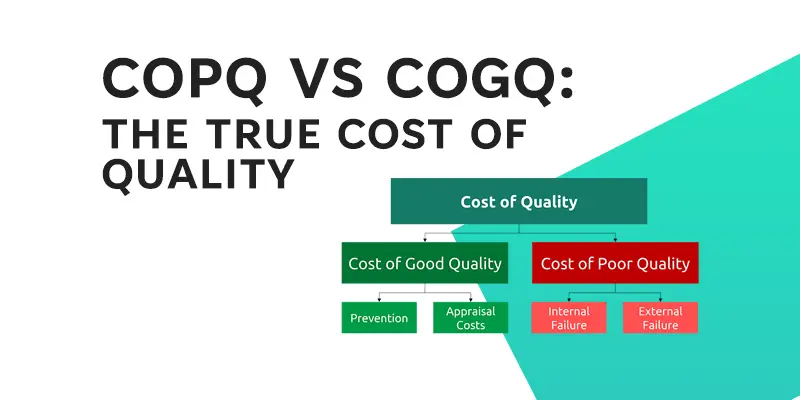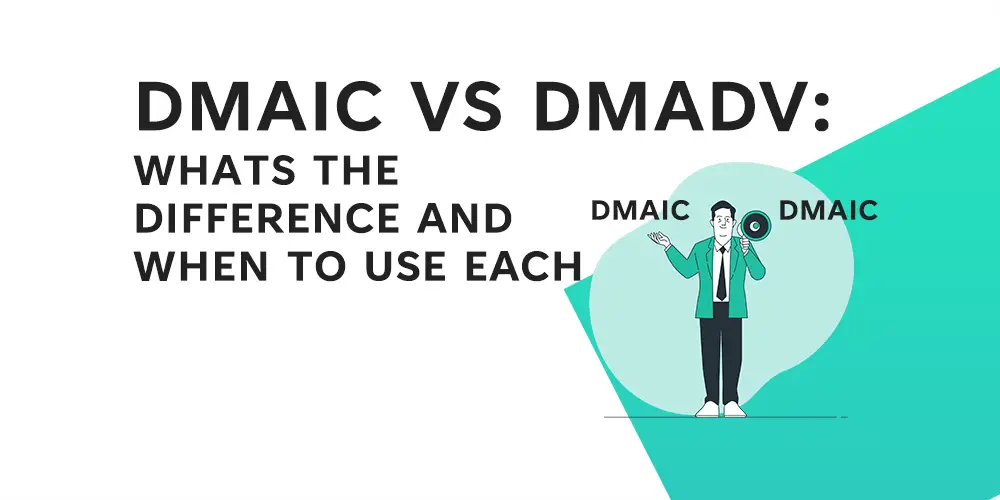Quality is not just a catchphrase in today’s competitive business environment; it is a fundamental pillar that influences customer satisfaction, brand reputation, and financial success. It is difficult but crucial to manage quality costs, especially the Cost of Poor Quality (COPQ) and the Cost of Good Quality (COGQ). I’ve created this comprehensive guide to demystify these important concepts using my extensive background in Lean Six Sigma and continuous improvement across industries like manufacturing, automotive, and the public sector.
Cost of Poor Quality (COPQ)
What is COPQ?
The Cost of Poor Quality (COPQ) refers to all of the costs associated with producing a defective product or service. It is not only about the obvious costs, such as rework or scrap, but also about the hidden costs, such as customer dissatisfaction or lost potential business. The following are the main components of COPQ:
- Internal Failure Costs: These include costs associated with defects found before reaching the customer, such as scrap, rework, and additional inspection.
- External Failure Costs: These include costs associated with defects found by the customer, including warranty claims, returns, and the long-term loss of customer trust.

Examples and Case Studies of COPQ from Manufacturing, Logistics, etc.
In my extensive work in various sectors, including manufacturing, logistics, and automotive, I’ve witnessed how COPQ can significantly impact a business. Here’s a brief case study from the automotive industry:
- Automaker: The company experienced a 15% increase in warranty claims due to a defect in a particular car model. By analyzing the COPQ, they identified the root cause and reduced warranty claims by 80%, saving millions annually.
Common Mistakes and Misconceptions about COPQ
Understanding COPQ is not always straightforward. Common mistakes include:
- Underestimating Hidden Costs: Many organizations focus on tangible costs like scrap and rework, ignoring the hidden costs like customer dissatisfaction.
- Lack of Proper Measurement: Without accurate measurement and tracking, organizations may overlook significant areas where COPQ is affecting their bottom line.
How Lean Six Sigma Techniques Help in Reducing COPQ
Lean Six Sigma principles play a crucial role in reducing COPQ. By focusing on continuous improvement and employing statistical tools, businesses can:
- Identify Root Causes: Through tools like Fishbone diagrams and 5 Whys.
- Implement Corrective Actions: Such as process optimization and preventive measures.
- Monitor Improvements: Using control charts and other statistical techniques.
Visual Representation: Charts and Graphs for COPQ Analysis
Understanding the major contributors to COPQ is essential for targeted improvement. A Pareto chart helps in this understanding by visualizing the significant areas that need attention. Below is an example of how a Pareto chart can identify the major contributors to COPQ in a manufacturing environment:
Pareto Chart: Major Contributors to COPQ

Here’s the Pareto chart visualizing the major contributors to the Cost of Poor Quality (COPQ) in a manufacturing environment:
- The green bars represent the individual percentages of each COPQ contributor.
- The orange line illustrates the cumulative percentage, showing how the most significant factors contribute to the overall COPQ.
By focusing on the largest contributors, such as rework and warranty claims, organizations can strategically target their improvement efforts, aligning with Lean Six Sigma principles.
If you have data of the COPQ in your business you may want to consider using that within our Pareto Chart Creator
Cost of Good Quality (COGQ)
What is COGQ?
The Cost of Good Quality (COGQ) is an essential concept in continuous improvement, encompassing the costs associated with ensuring a product or service meets quality standards. Unlike COPQ, which measures the cost of failures, COGQ focuses on prevention and appraisal. The main components of COGQ are:
- Prevention Costs: These include the costs related to preventing defects, such as training, process design, and quality planning.
- Appraisal Costs: These include the costs associated with evaluating products and services to ensure quality, such as inspections, testing, and audits.

Difference between Prevention Costs and Appraisal Costs
Understanding the difference between prevention and appraisal costs is vital:
- Prevention Costs: Aimed at avoiding defects altogether. Investment in quality planning, training, and preventive maintenance falls under this category.
- Appraisal Costs: Focus on detecting defects before they reach the customer. Activities such as inspections, testing, and quality audits are part of appraisal costs.
Strategically balancing these two components can lead to optimal quality management.
Strategies to Optimize COGQ
To achieve a balance between prevention and appraisal costs, consider the following strategies:
- Invest in Training and Education: Educate teams on quality standards and best practices.
- Implement Process Controls: Utilize statistical process control and other Lean Six Sigma tools.
- Focus on Continuous Improvement: Regularly review and refine processes to maintain quality.
Case Studies: Success Stories in Implementing COGQ in Various Industries
Manufacturer: Reducing Defects Through Prevention Costs
Situation: A manufacturer was facing a challenge with a high defect rate in one of their key product lines. The defects were leading to increased warranty claims, customer dissatisfaction, and a negative impact on the brand’s reputation.
Action: Recognizing that a focus on prevention could yield significant benefits, the manufacturer invested in the following areas:
- Quality Training: Employees were provided extensive training on quality standards, best practices, and process control techniques.
- Process Redesign: The company implemented Lean Six Sigma principles to redesign critical manufacturing processes, eliminating potential defect sources.
- Preventive Maintenance: A robust preventive maintenance schedule was established to ensure that machinery and equipment were always in optimal condition.
Result: By concentrating on prevention costs, the manufacturer was able to reduce defects by 30%. This improvement led to a significant decrease in warranty claims, increased customer satisfaction, and enhanced brand perception. Moreover, the savings realized from reduced rework and scrap were reinvested in further quality initiatives, creating a continuous cycle of improvement.
Logistics Company: Enhancing On-Time Delivery Through Appraisal Costs
Situation: A Logistics Company was struggling with timely deliveries. Delays were affecting customer satisfaction and trust, and the company was losing business to competitors.
Action: The company decided to focus on rigorous appraisal processes to tackle this issue:
- Real-time Tracking: Implementation of real-time tracking systems allowed close monitoring of shipments, enabling timely interventions if delays were detected.
- Quality Audits: Regular audits of logistics processes ensured that potential bottlenecks were identified and addressed promptly.
- Vendor Assessment: Vendors and partners were continuously assessed for compliance with delivery schedules, ensuring alignment with the company’s on-time delivery goals.
Result: Through these focused appraisal processes, the Company achieved a remarkable 99% on-time delivery rate. This accomplishment had a direct positive impact on customer satisfaction and loyalty. The enhanced reputation helped the company secure new clients and grow in a highly competitive market. Furthermore, the data gathered through the appraisal processes provided insights for continuous improvement, fostering a culture of excellence within the organization.
Relationship Between COPQ and COGQ
How COPQ and COGQ Complement Each Other
COPQ and COGQ are not opposing forces in quality management, but rather complementary aspects of it. COGQ focuses on the investment in maintaining quality, whereas COPQ identifies and quantifies the cost of failures. They provide a comprehensive picture of an organization’s quality-related costs when used together. Understanding both aspects allows businesses to make informed decisions, aligning quality efforts with overall business objectives.

Strategies to Balance Both for Optimal Performance
Balancing COPQ and COGQ requires a strategic approach:
- Analyze Both Costs: Regularly assess both COPQ and COGQ to identify trends and areas for improvement.
- Set Clear Quality Objectives: Define quality goals aligned with business objectives and customer expectations.
- Implement Targeted Improvements: Utilize Lean Six Sigma tools to prioritize and address areas that impact both COPQ and COGQ.
- Monitor Progress: Establish key performance indicators (KPIs) to monitor the effectiveness of quality initiatives.
Utilizing Lean Six Sigma Principles for Managing COPQ and COGQ
Lean Six Sigma offers a robust framework for managing both COPQ and COGQ:
- DMAIC Methodology: Apply the Define, Measure, Analyze, Improve, Control (DMAIC) approach to manage quality costs effectively.
- Statistical Tools: Employ tools such as control charts, process mapping, and root cause analysis to identify and mitigate quality issues.
- Continuous Improvement Culture: Foster a culture that emphasizes ongoing improvement, enhancing both the efficiency of quality processes and customer satisfaction.
Practical Guidelines and Tools
Step-by-Step Guide to Implementing COPQ and COGQ in Your Organization
Implementing COPQ and COGQ effectively requires a strategic approach. Here’s a step-by-step guide tailored to your needs:
- Assess Current State: Analyze existing quality costs and identify areas for improvement.
- Define Objectives: Set clear quality goals aligned with your organization’s strategy.
- Select Tools and Techniques: Choose appropriate Lean Six Sigma tools, such as control charts and root cause analysis.
- Implement Changes: Apply changes in processes to reduce COPQ and optimize COGQ.
- Monitor Progress: Use KPIs to track success and make necessary adjustments.
- Foster Continuous Improvement: Encourage a culture of ongoing quality enhancement.
Tips for Automotive, FMCG, Public Sector, and Other Industries
Different industries may require unique approaches to managing COPQ and COGQ. Here are some tailored tips:
- Automotive: Focus on supplier quality and robust design to reduce defects and warranty claims.
- FMCG (Fast-Moving Consumer Goods): Implement rigorous quality checks to ensure consistency across high-volume production.
- Public Sector: Emphasize transparency and compliance with regulations to meet quality standards.
Automotive: Focus on Supplier Quality and Robust Design
Situation: The automotive industry is characterized by complex supply chains and high customer expectations for safety and performance. Defects can lead to significant warranty claims, recalls, and damage to brand reputation.
Strategies:
- Supplier Quality Management:
- Assessment: Regularly evaluate suppliers based on quality metrics and performance.
- Collaboration: Work closely with suppliers to align quality expectations and share best practices.
- Monitoring: Implement real-time tracking of supplier performance to ensure timely interventions.
- Robust Design Principles:
- Design for Six Sigma (DFSS): Utilize DFSS methodologies to design products that meet stringent quality standards.
- Failure Mode and Effects Analysis (FMEA): Identify potential failure modes in design and manufacturing to mitigate risks.
- Prototyping and Testing: Implement rigorous testing protocols to catch defects early in the design phase.
Outcome: By focusing on supplier quality and robust design, automotive companies can significantly reduce defects, minimize warranty claims, and enhance customer satisfaction, ensuring a competitive edge in the market.
FMCG (Fast-Moving Consumer Goods): Rigorous Quality Checks
Situation: The FMCG industry deals with high-volume production and rapid turnover of products. Consistency in quality is vital to meet customer expectations and regulatory requirements.
Strategies:
- Quality Control Points:
- Identification: Determine critical control points where quality checks can be most effective.
- Automation: Implement automated inspection systems to ensure consistency across large production runs.
- Continuous Monitoring: Regularly review quality control data to detect trends and make improvements.
- Supplier Collaboration:
- Alignment: Ensure suppliers adhere to quality standards suitable for high-volume production.
- Audits: Conduct regular audits to validate supplier compliance with agreed quality levels.
Outcome: Rigorous quality checks in the FMCG industry lead to consistent product quality across high-volume production. This approach minimizes variations, reduces waste, and maintains customer trust, vital for success in a competitive marketplace.
Conclusion
Understanding and controlling the Cost of Poor Quality (COPQ) and the Cost of Good Quality (COGQ) are essential for achieving excellence and maintaining growth in the complex world of modern business. This guide has shed light on how these two quality cost components complement one another and contribute to organizational success overall by dissecting the complex relationship between them. The strategies presented here offer practical insights into supplier quality in various industry contexts, from the automotive industry to transparency measures in the public sector.
Lean Six Sigma principles, coupled with robust statistical tools and templates available on my website, offer a comprehensive toolkit for those aspiring to elevate their quality management efforts. Whether you’re a seasoned Continuous Improvement Manager or just beginning your journey in quality management, these guidelines serve as a valuable roadmap. The continuous pursuit of quality is not merely a technical exercise but a cultural commitment that resonates with customers, empowers employees, and drives innovation. I invite you to explore the tools, calculators, and templates on my website, and engage with the shared goal of excellence, for quality is not a destination but a continuous journey.
References
Prashar, A., 2014. Adoption of Six Sigma DMAIC to reduce cost of poor quality. International Journal of Productivity and Performance Management, 63(1), pp.103-126.
Mahmood, S., M. Ahmed, S., Panthi, K. and Ishaque Kureshi, N., 2014. Determining the cost of poor quality and its impact on productivity and profitability. Built Environment Project and Asset Management, 4(3), pp.296-311.
Cosmin, D. and Ana-Maria, S., 2013. Cost of quality and Taguchi loss function. Annals of the University Of Oradea, Economic Science Series, 22(1), pp.1479-1485.
Ashraf, S.R., 2015. Compare cost of good quality & cost of poor quality and have a wise decision: A study from automobile industry of Pakistan.








